We may not have the course you’re looking for. If you enquire or give us a call on +64 98874342 and speak to our training experts, we may still be able to help with your training requirements.
Training Outcomes Within Your Budget!
We ensure quality, budget-alignment, and timely delivery by our expert instructors.
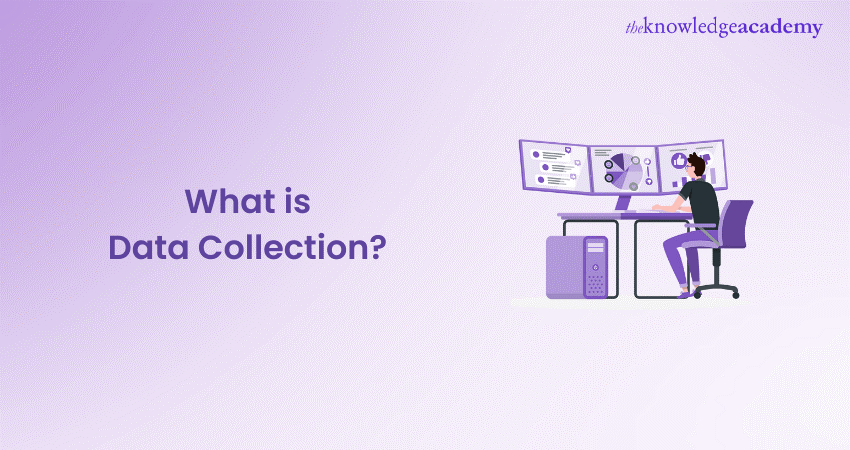
Understanding Data Collection is like having a treasure map oftohidden gems, but exactly What is Data Collection? It’s the art and science of systematically gathering information from diverse sources. Imagine it as assembling puzzle pieces—one by one—to create a complete picture. This process is powered by a range of sophisticated methods and tools, from surveys and observations to cutting-edge technology.
In this blog, we will take you through What is Data Collection, its importance, the methods behind it, and the tools that bring it to life. So, dive into the world of data and uncover how it can illuminate the path to success.
Table of Contents
1) What is Data Collection?
2) Why is Data Collection Necessary?
3) Goals and Objectives of Data Collection
4) Data Collection Methods
5) Tools for Collecting Data
6) Key Steps for Data Collection
7) What are Common Challenges in Data Collection?
8) Data Collection Considerations and Best Practices
9) What is the Reason for Data Being Collected Online?
10) Why is it Good to Collect More Data?
11) Conclusion
What is Data Collection?
Data Collection involves gathering and scrutinising data from various sources to address research queries, provide solutions, assess results, and predict patterns and likelihoods. This critical stage is fundamental to research, analysis, and decision-making processes across diverse fields such as social sciences, commerce, and healthcare.
Why is Data Collection Necessary?
The necessity of Data Collection lies in its role as an illuminating force, providing context, mitigating uncertainties, and fostering informed decision-making. It is an essential need rather than a mere task, offering a holistic perspective in a world inundated with information.
Data Collection becomes necessary by filtering through the noise and extracting valuable insights from many Data points. It is a vital component in scientific research, establishing facts and theories. Moreover, Data Collection is a risk mitigation tool that enables proactive decision-making in business and healthcare.
Data Collection is the compass guiding individuals, organisations, and researchers through the vast landscape of information. It is a proactive approach to understanding market dynamics, anticipating trends, and making decisions that resonate with purpose and precision. As we explore the intricacies of Data Collection, acknowledging its necessity becomes paramount, emphasising its transformative impact on our comprehension of the world.
Unlock the future of technology with our Data Science and Blockchain Training – sign up and embrace innovation today!
Goals and Objectives of Data Collection
The goals and objectives of Data Collection can vary depending on the context and the needs of an organisation or research project. However, some common overarching objectives include:
1) Information Gathering: The primary aim is to collect accurate, relevant, and reliable information to address specific questions or objectives.
2) Analysis and Insight: Data is analysed to uncover patterns, trends, relationships, and insights that can inform decision-making and strategy development.
3) Measurement and Evaluation: Data Collection allows for the measurement and evaluation of various factors, such as performance, customer satisfaction, or market potential.
4) Problem Solving: It helps identify and solve specific problems or challenges faced by an organisation, such as pinpointing the root causes of quality issues.
5) Monitoring and Surveillance: Continuous Data Collection enables organisations to track ongoing processes or conditions, ensuring they stay on top of any changes.
6) Benchmarking: Data can be used to benchmark against industry standards or competitors, helping organisations assess their performance relative to others.
7) Planning and Strategy: Over time, collected data supports long-term planning and strategy development, ensuring organisations can adapt to changing circumstances.
Data Collection is a foundational activity with diverse applications across industries and sectors. Its objectives range from understanding customers and making informed decisions to improving processes, managing risks, and driving innovation. The quality and relevance of the data collected are crucial in achieving these goals.
Data Collection Methods
Data Collection, a multifaceted process, employs various methods to gather information. These methods are crucial in shaping the reliability and depth of the insights derived. Let's navigate through two primary avenues: gathering and obtaining secondary Data.
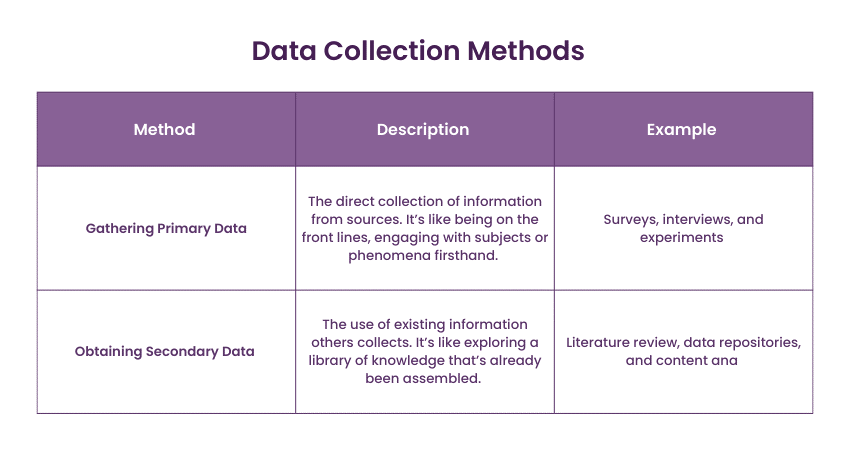
1) Gathering Primary Data
This method involves the direct collection of information from sources. It's like being on the front lines, engaging with subjects or phenomena firsthand. Techniques encompass surveys, interviews, and experiments, each offering a unique perspective.
a) Surveys: Imagine casting a wide net to capture diverse opinions. Surveys use structured questionnaires to gather responses from a sample population, providing quantifiable Data. This method is particularly useful in studying large groups or identifying trends.
b) Interviews: If surveys are like casting a net, interviews are akin to a one-on-one conversation. This method allows for in-depth exploration, extracting detailed insights and nuances that might be missed in broader surveys.
c) Experiments: Think of experiments as controlled scenarios where variables are manipulated to observe outcomes. This method is prevalent in scientific research, providing a hands-on approach to Data Collection and hypothesis testing.
2) Obtaining Secondary Data
While primary Data is firsthand, secondary Data involves using existing information others collect. It's like exploring a library of knowledge that's already been assembled. This method is efficient, cost-effective, and often complements primary Data.
a) Literature Review: In the academic realm, a literature review examines existing studies, articles, and publications related to the research topic. It's about leveraging the insights and findings of others to inform and support your research.
b) Data Repositories: In the digital age, vast Data repositories are readily available. These can include government Databases, research institutions, or industry reports. These existing Datasets can provide a wealth of information without requiring direct Data Collection.
c) Content Analysis: In a world overflowing with textual information, content analysis involves systematically evaluating and interpreting the content of documents. It includes text from books, articles, or social media, offering insights into trends, sentiments, and themes.
Elevate your Data Science expertise with our Advanced Data Science Certification and unleash the power of data-driven innovation today.
Tools for Collecting Data
Data Collection is not only about surveys and interviews; it also involves employing creative tools that delve into the intricacies of human thought and behaviour. Let's explore three distinctive tools for collecting Data: Word Association, Completing Sentences, and Role-Playing.
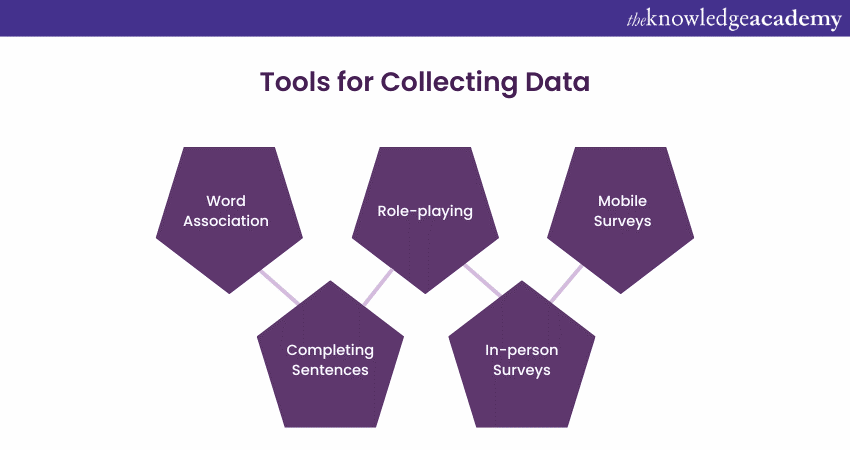
1) Word Association
Think of word association as a unique window into the subconscious. It's a tool that taps into the way individuals connect words, revealing implicit thoughts and associations that might not surface in direct questioning.
Participants are presented with a stimulus word in a typical word association exercise, and their immediate response is noted. The associations can be analysed to uncover patterns, sentiments, or hidden connections. For instance, if the stimulus is "work," responses might include "effort," "office," or "productivity." These associations unveil the mental connections individuals have with the given concept.
Word association is particularly valuable when exploring attitudes, preferences, or emotions. It provides a qualitative dimension to Data Collection, giving researchers a nuanced understanding of the subjective aspects of an individual's experience or perception.
2) Completing Sentences
Completing sentences is a straightforward yet powerful tool in Data Collection. It involves presenting respondents with partial sentences and asking them to fill in the blanks. This method provides structured responses, offering insights into beliefs, opinions, or experiences.
For instance, a partial sentence like "I feel happiest when..." can prompt participants to complete it with personal sentiments, shedding light on the factors contributing to their happiness. This tool allows for a more guided exploration of specific topics, making it useful in qualitative and quantitative research.
Completing sentences is versatile and adaptable to various research objectives. It provides a middle ground between the openness of interviews and the structure of surveys, offering a balance that captures the richness of individual perspectives.
3) Role-playing
Imagine stepping into different shoes to understand a situation better—that's the essence of role-playing as a Data Collection tool. It involves participants assuming specific roles or scenarios to simulate real-life situations, allowing researchers to observe behaviours and responses in a controlled environment.
In a business context, for example, role-playing might be used to simulate customer interactions or team dynamics. Participants take on roles such as customers, employees, or managers, providing insights into how they would navigate specific scenarios. This method is particularly effective in studying interpersonal dynamics, decision-making processes, and problem-solving skills.
Role-playing adds a dynamic and interactive dimension to Data Collection. It's not just about what individuals say; it's about observing their actions and reactions in real-time scenarios. This tool bridges the gap between hypothetical scenarios and actual behaviours, offering a more immersive understanding of human responses.
4) In-person Surveys
In-person questioning involves a researcher directly interacting with participants to pose questions and collect responses. This face-to-face approach facilitates a more nuanced understanding of the answers, as the researcher can observe non-verbal cues, including gestures and facial expressions, which can provide additional context to the verbal responses. It’s a method often used for its ability to capture depth and detail in the data that might be missed in less direct forms of surveying.
For example, structured interviews are a formal approach where the researcher asks a set of predetermined questions. Focus groups, in contrast, involve moderated discussions with a group of people to explore complex behaviours and motivations. Both methods are valuable for obtaining detailed insights that might not emerge through other Data Collection techniques.
5) Mobile Surveys
These surveys capitalise on the widespread adoption of mobile technology. They employ tablets and smartphones to facilitate survey distribution through SMS or mobile applications. Mobile surveys are becoming increasingly integral to Data Collection strategies, leveraging the widespread use of mobile technology. They utilise the convenience and connectivity of smartphones and tablets to gather information through SMS or dedicated mobile applications.
For instance, “Survicate” offers mobile app surveys that enable businesses to collect user feedback directly within their applications. This approach not only facilitates real-time Data Collection but also enhances user engagement by providing a seamless experience for participants.
Similarly, “QuestionPro” emphasises the importance of mobile-friendly surveys that adapt to multiple screen sizes, ensuring optimal respondent experience across devices. These tools exemplify the innovative use of mobile technology in capturing valuable insights for research and decision-making.
Unlock the power of data with our comprehensive Data Mining Training – register today and transform raw information into valuable insights!
Key Steps for Data Collection
Efficient Data Collection and analysis are necessary for organisations, scholars, and policymakers to derive insightful information and make well-informed choices. Whether it’s for probing market trends, examining consumer habits, or refining operational methods, adhering to fundamental steps in the Data Collection procedure can significantly improve the calibre and applicability of your data. Here are some vital steps to keep in mind:
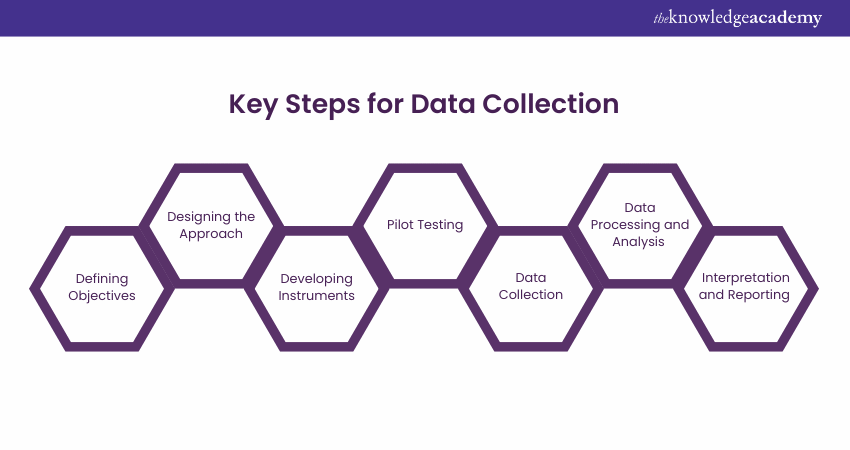
a) Define Your Objectives: Establish clear research goals to steer your Data Collection.
b) Choose the Right Methods: Opt for suitable data gathering techniques like surveys, interviews, or observations that align with your goals.
c) Design Data Collection Instruments: Create specific tools such as questionnaires or interview outlines to collect pertinent information.
d) Collect Data: Execute the Data Collection in a methodical manner, maintaining uniformity and ethical standards.
e) Validate Your Data: Confirm the accuracy and authenticity of the data to ensure its trustworthiness.
f) Analyse Your Data: Employ statistical methods to reveal significant trends and correlations.
g) Interpret Your Findings: Formulate conclusions based on the Data Analysis, taking into account other potential interpretations.
h) Communicate Your Results: Share the outcomes of your research effectively with your stakeholders through detailed reports, visual aids, or presentations.
Master the strategy of extracting actionable insights from complex data sets with our Data Science Analytics Training – propel your career in the era of Big Data.
What are Common Challenges in Data Collection?
Common obstacles encountered in Data Collection can be summarised as follows:
a) Data Quality Concerns: Typically, raw data is riddled with errors, discrepancies, and various issues. Data Collection strategies aim to prevent or reduce these problems, but they are not always completely effective. Consequently, it is often necessary to engage in data profiling to detect problems and data cleansing to resolve them.
b) Locating Pertinent Data: Navigating through an array of systems to collect analysable data poses a complex challenge for data scientists and other organisational members. Implementing data curation practices, such as establishing a data catalogue and creating searchable indices, can facilitate easier data discovery and access.
c) Selection of Data: A critical decision is made to determine the specific data to collect, both initially and for subsequent analytics use. Accumulating unnecessary data increases time, expense, and complexity, whereas omitting valuable data can diminish the business utility of a dataset and impact the outcomes of analytics.
d) Handling Big Data: Big data frameworks often encompass vast quantities of structured, unstructured, and semi-structured data, complicating the initial stages of Data Collection and processing. Data scientists frequently need to sift through raw data in a data lake to isolate data pertinent to particular analytics endeavours.
e) Response Rates and Research Validity: In research, insufficient responses or a shortage of participants can spread doubt about the validity of the collected data. Additional challenges include instructing individuals on Data Collection techniques and instituting robust quality assurance measures to guarantee data accuracy.
Data Collection Considerations and Best Practices
Data Collection encompasses two fundamental categories: quantitative and qualitative data. Quantitative data is numerical and includes elements such as prices, quantities, statistics, and ratios. In contrast, qualitative data is descriptive, capturing aspects like colour, aroma, texture, and personal views.
Moreover, organisations often incorporate secondary data from external sources to inform their business strategies. It’s crucial for an organisation’s data governance framework to establish policies that align with legal standards, including regulations like the GDPR, to ensure responsible Data Collection practices. Best practices in Data Collection involve:
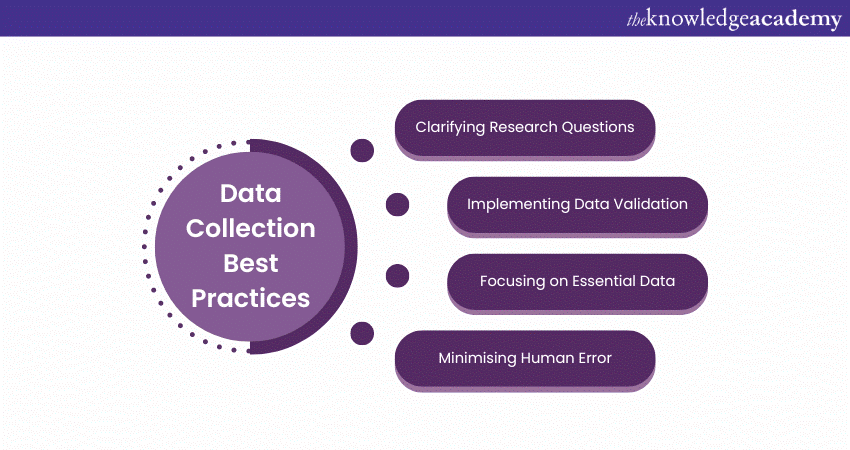
1) Comprehend the purpose behind Data Collection to guarantee that the data acquired is pertinent to the business or research objectives.
2) Confirm the precision of data, either during collection or throughout data preparation, to maintain data quality.
3) Avoid the extraneous effort and resources by targeting only the data that is necessary.
4) Embrace automated Data Collection methods to diminish the risk of human mistakes.
What is the Reason for Data Being Collected Online?
Data is collected online to gain insights, make informed decisions, and improve services. It enables businesses to understand user behaviour, personalise experiences, optimise processes, and drive innovation, all while leveraging the speed and reach of digital platforms.
Why is It Good to Collect More Data?
Collecting more data provides a broader and deeper understanding of patterns, trends, and behaviours. It enhances decision-making accuracy, improves predictions, supports innovation, and ensures more comprehensive solutions by reducing biases and uncovering hidden insights.
Master the strategy of extracting actionable insights from complex data sets with our Data Science Analytics Training – propel your career in the era of Big Data.
Conclusion
In conclusion, we hope our blog on What is Data Collection firmly grasped you with the methods and tools that can shape the future. The power of data lies not just in its collection but in the stories, it tells and the decisions it informs. As you embark on this data-driven adventure, anticipate a horizon teeming with possibilities.
Elevate your analytics expertise with our Data Warehousing Training – harness the full potential of Big Data for strategic decision-making.
Frequently Asked Questions

Primary Data Collection methods include surveys, interviews, focus groups, observations, and experiments. These methods gather firsthand information directly from sources, providing accurate and relevant data for research, analysis, and decision-making.

Quantitative Data Collection methods involve structured techniques like surveys with closed-ended questions, experiments, and statistical sampling. These methods focus on collecting numerical data that can be analysed using mathematical models to identify patterns and draw conclusions.

The Knowledge Academy takes global learning to new heights, offering over 30,000 online courses across 490+ locations in 220 countries. This expansive reach ensures accessibility and convenience for learners worldwide.
Alongside our diverse Online Course Catalogue, encompassing 17 major categories, we go the extra mile by providing a plethora of free educational Online Resources like News updates, Blogs, videos, webinars, and interview questions. Tailoring learning experiences further, professionals can maximise value with customisable Course Bundles of TKA.

The Knowledge Academy’s Knowledge Pass, a prepaid voucher, adds another layer of flexibility, allowing course bookings over a 12-month period. Join us on a journey where education knows no bounds.

The Knowledge Academy offers various Data Science Courses, including the Python Data Science Course, Text Mining Training, and Predictive Analytics Course. These courses cater to different skill levels, providing comprehensive insights into Data Reconciliation.
Our Data, Analytics & AI Blogs cover a range of topics related to Data Collection Methods, offering valuable resources, best practices, and industry insights. Whether you are a beginner or looking to advance your Data Analysis skills, The Knowledge Academy's diverse courses and informative blogs have got you covered.
Upcoming Data, Analytics & AI Resources Batches & Dates
Date
 Data Science and Blockchain Training
Data Science and Blockchain Training
Fri 28th Mar 2025
Fri 23rd May 2025
Fri 4th Jul 2025
Fri 5th Sep 2025
Fri 24th Oct 2025







 Top Rated Course
Top Rated Course



 If you wish to make any changes to your course, please
If you wish to make any changes to your course, please


